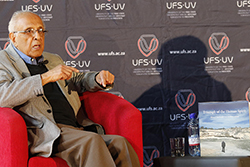
Ahmed Kathrada discusses his latest book, Triumph of the Human Spirit.
Photo: Johan Roux |
“A triumph of courage and determination over human frailty and weakness; a triumph of the new South Africa over the old.” – Ahmed Kathrada |
Ahmed Kathrada, stalwart of South Africa’s liberation struggle, visited the Bloemfontein Campus on 18 August 2015 to launch his latest book, Triumph of the Human Spirit. Turning page after page, the reader travels back with Uncle Kathy – as he is fondly known – to revisit Robben Island with the more than 300 guests he has accompanied since 1994. With each photo – be it a celebrity or school child, head of state or famous artist, friend or royalty – the significance of the island is eternalised, right alongside Ahmed Kathrada.
Message of triumph
“Why this specific title for the book?” Prof André Keet, Director of the Institute for Reconciliation and Social Justice (IRSJ), asked during the book launch. “Robben Island,” Kathrada answered, “should not be remembered only as a place of suffering – that’s history. But the message of Robben Island is the message of triumph – triumph of the human spirit over all sorts of adversities.”
Speaking about Kathrada’s quiet but profound impact, Zaakirah Vadi, editor of the book, said “I think Uncle Kathy does not realise what an inspiration his own strength of spirit is”. The fight for human values and dignity was “honed and perfected in the cells of Robben Island,” she said. “It created the vision for a new South Africa and, as Uncle Kathy puts it, the triumph of the new South Africa over the old.”

UFS surprises Ahmed Kathrada with a birthday cake.
Photo: Johan Roux |
Freedom was sacrifice
This triumph was not achieved without a cost, though. “No freedom comes on a platter,” Kathrada said. “Freedom was fought for. Freedom was sacrifice. Through the sacrifices of those who did not survive, we are still here to tell the story.”
And that is exactly what Triumph of the Human Spirit does. As Kgalema Motlanthe writes in the foreword, “This book serves as a preservation of history and a symbol of hope.”
Birthday celebration
Just as the event seemed to come to a close, members of the Student Representative Council carried a candle-lit cake – shaped in the number 86 – toward Kathrada. This surprise was organised by the UFS to celebrate his birthday on 21 August 2015. And, as the audience cheered and sang, Kathrada’s smile spread like a light across the hall.